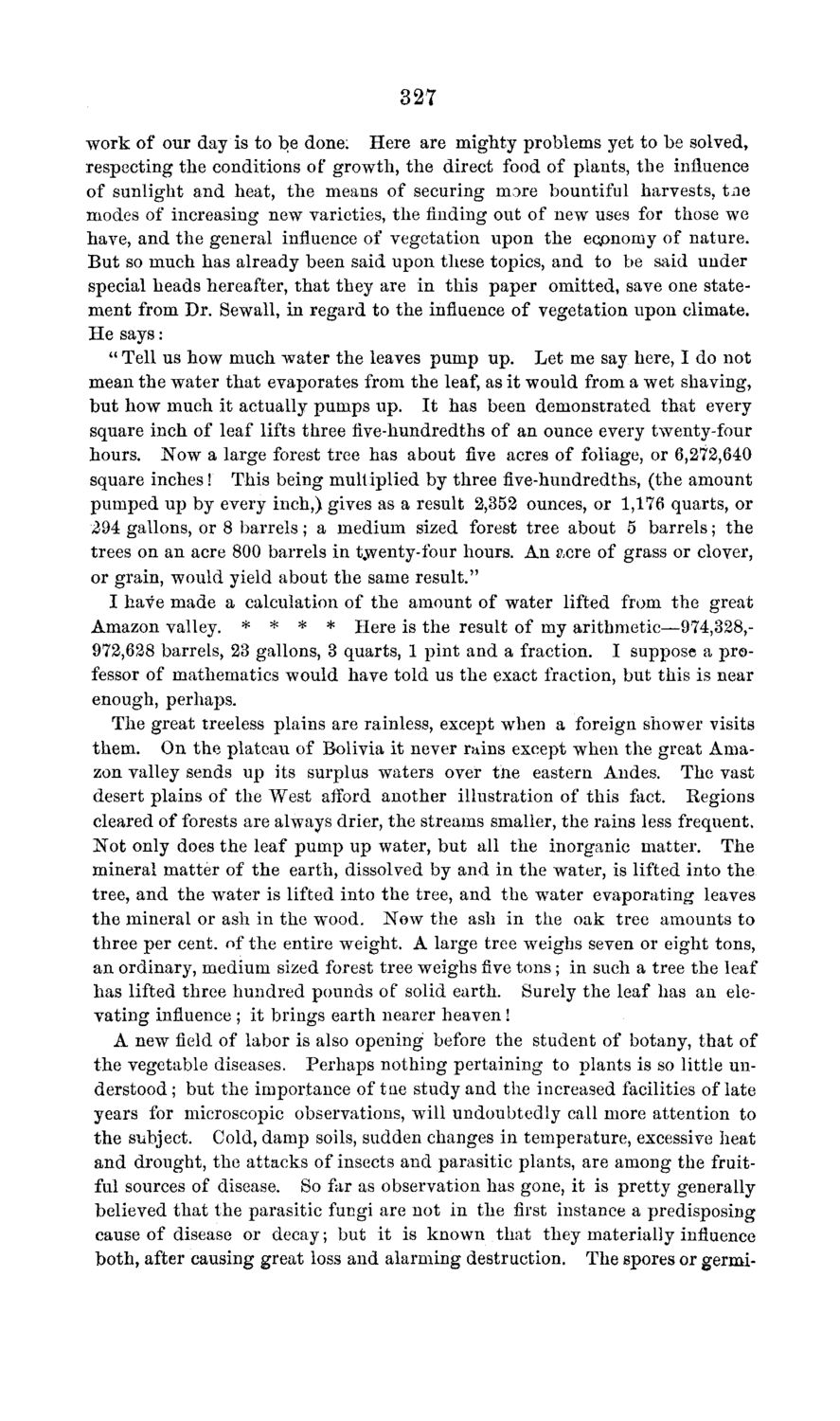| |
| |
Caption: Board of Trustees Minutes - 1869
This is a reduced-resolution page image for fast online browsing.

EXTRACTED TEXT FROM PAGE:
327 work of our day is to be done: Here are mighty problems yet to be solved, respecting the conditions of growth, the direct food of plants, the influence of sunlight and heat, the means of securing more bountiful harvests, tne modes of increasing new varieties, the finding out of new uses for those we have, and the general influence of vegetation upon the economy of nature. But so much has already been said upon these topics, and to be said under special heads hereafter, that they are in this paper omitted, save one statement from Dr. Sewall, in regard to the influence of vegetation upon climate. He says: " Tell us how much water the leaves pump up. Let me say here, I do not mean the water that evaporates from the leaf, as it would from a wet shaving, but how much it actually pumps up. I t has been demonstrated that every square inch of leaf lifts three five-hundredths of an ounce every twenty-four hours. Now a large forest tree has about five acres of foliage, or 6,272,640 square inches! This being multiplied by three five-hundredths, (the amount pumped up by every inch,) gives as a result 2,352 ounces, or 1,176 quarts, or 294 gallons, or 8 barrels; a medium sized forest tree about 5 barrels; the trees on an acre 800 barrels in twenty-four hours. An &cre of grass or clover, or grain, would yield about the same result." I have made a calculation of the amount of water lifted from the great Amazon valley. * * * * Here is the result of my arithmetic—974,328,972,628 barrels, 23 gallons, 3 quarts, 1 pint and a fraction. I suppose a professor of mathematics would have told us the exact fraction, but this is near enough, perhaps. The great treeless plains are rainless, except when a foreign shower visits them. On the plateau of Bolivia it never rains except when the great Amazon valley sends up its surplus waters over the eastern Andes. The vast desert plains of the West aiford another illustration of this fact. Regions cleared of forests are always drier, the streams smaller, the rains less frequent. Not only does the leaf pump up water, but all the inorganic matter. The mineral matter of the earth, dissolved by and in the water, is lifted into the tree, and the water is lifted into the tree, and the> water evaporating leaves t h e mineral or ash in the wood. Now the ash in the oak tree amounts to three per cent, of the entire weight. A large tree weighs seven or eight tons, an ordinary, medium sized forest tree weighs five tons ; in such a tree the leaf has lifted three hundred pounds of solid earth. Surely the leaf has an elevating influence ; it brings earth nearer heaven ! A new field of labor is also opening before the student of botany, that of the vegetable diseases. Perhaps nothing pertaining to plants is so little understood ; but the importance of tne study and the increased facilities of late years for microscopic observations, will undoubtedly call more attention to the subject. Cold, damp soils, sudden changes in temperature, excessive heat and drought, the attacks of insects and parasitic plants, are among the fruitful sources of disease. So far as observation has gone, it is pretty generally believed that the parasitic fungi are not in the first instance a predisposing cause of disease or decay; but it is known that they materially influence both, after causing great loss and alarming destruction. The spores or germi-
| |